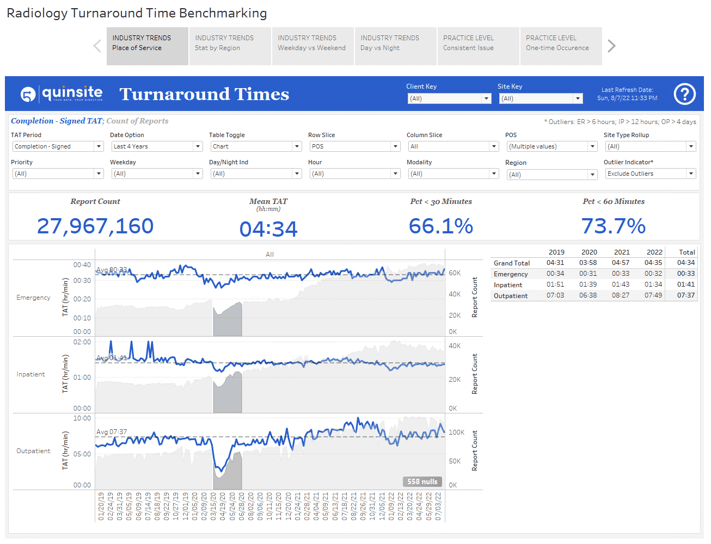3 Ways Integrated Data Analytics Improve Quality in Healthcare
3 Ways Integrated Data Analytics Improve Quality in Healthcare

Turnaround times (TATs) are a hot topic for today’s provider groups. Most practice leaders understand that improved TATs lead to improved quality of care, strong partner facility relationships, and a healthy bottom line. Access and analysis of the right data points will help you better understand TAT trends and details to enhance the level of service your practice offers.
Healthcare thought leader Keith Chew joined Quinsite CEO Jeff Maze for a webinar last week to discuss TAT trends. They combined Keith’s extensive healthcare expertise, Jeff’s innovative data analytics expertise, and real data from radiology groups across the country to discuss best practices and valuable insights. Their goal was for practice leaders to understand key factors that impact TATs, how to identify TAT variances and patterns within their own practice, and how to leverage TAT insights to solve problems and inform strategic practice decisions.
Jeff shared a Quinsite analysis of radiology industry trends from 2019-2022 that included 30 million studies performed by 25 private radiology practices located across the US, with TAT benchmarking data broken down by the following:
Jeff showed how individual practices can slice and dice TAT data by site, modality, shift, ordering provider, performing provider, and other variables to identify trends and potential issues that need attention. It was a great opportunity for attendees to see how their practice TATs compare to industry benchmarks and gain a better understanding of how to leverage their own data.

Keith brought everything into focus by reminding us that while contractual requirements (Professional Service Agreement TAT metrics) are important, turnaround times play a key role in radiology’s quest to provide high quality care, “Being certain that the report aligns appropriately with the severity of the diagnostic question being asked is extremely important to understanding the role radiology can play. From my perspective, that's the big point of all of this.”
The one-hour discussion covered many factors related to turnaround times including financial impact, physician productivity, physician burnout, recruitment and retention, comparative studies, referring provider behavior, patient acuity, staffing levels, partner conversations and so much more.
If you missed the webinar, here is a recap of some key insights and takeaways shared by Keith and Jeff
Important data points to capture for effective TAT tracking and analysis:
Key Takeaways:
You can access a recording of the complete webinar here. If you would like to learn more about turnaround times, please contact us!

3 Ways Integrated Data Analytics Improve Quality in Healthcare

ARA Health Specialists (ARAHS) is a comprehensive, 63-physician multispecialty practice serving...

Emerging Leader in Disparate Data Aggregation and Analysis for Radiology Practices Plans to Expand...